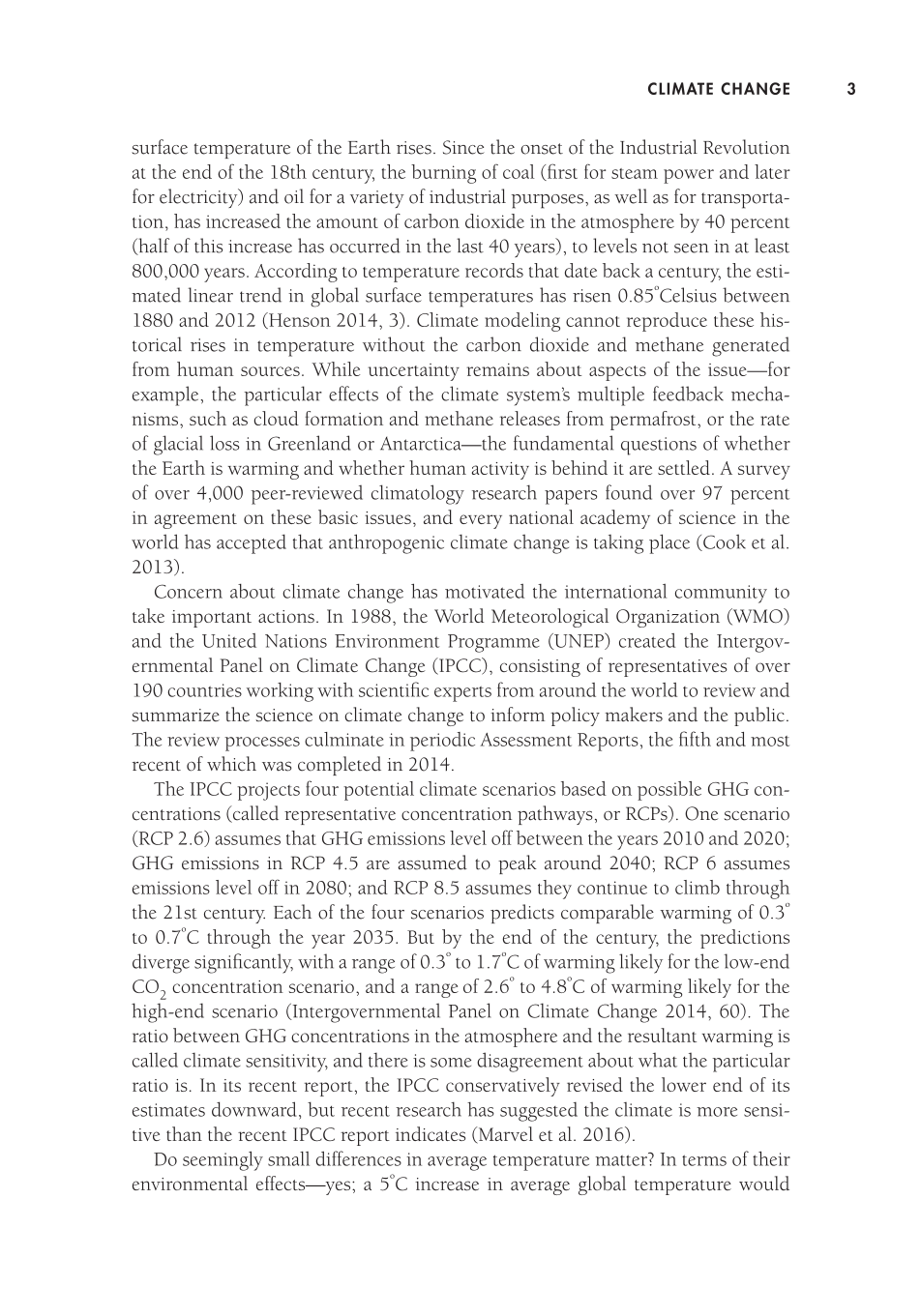Climate Change 3
surface temperature of the Earth rises. Since the onset of the Industrial Revolution
at the end of the 18th century, the burning of coal (first for steam power and later
for electricity) and oil for a variety of industrial purposes, as well as for transporta-
tion, has increased the amount of carbon dioxide in the atmosphere by 40 percent
(half of this increase has occurred in the last 40 years), to levels not seen in at least
800,000 years. According to temperature records that date back a century, the esti-
mated linear trend in global surface temperatures has risen 0.85ºCelsius between
1880 and 2012 (Henson 2014, 3). Climate modeling cannot reproduce these his-
torical rises in temperature without the carbon dioxide and methane generated
from human sources. While uncertainty remains about aspects of the issue—for
example, the particular effects of the climate system’s multiple feedback mecha-
nisms, such as cloud formation and methane releases from permafrost, or the rate
of glacial loss in Greenland or Antarctica—the fundamental questions of whether
the Earth is warming and whether human activity is behind it are settled. A survey
of over 4,000 peer-reviewed climatology research papers found over 97 percent
in agreement on these basic issues, and every national academy of science in the
world has accepted that anthropogenic climate change is taking place (Cook et al.
2013).
Concern about climate change has motivated the international community to
take important actions. In 1988, the World Meteorological Organization (WMO)
and the United Nations Environment Programme (UNEP) created the Intergov-
ernmental Panel on Climate Change (IPCC), consisting of representatives of over
190 countries working with scientific experts from around the world to review and
summarize the science on climate change to inform policy makers and the public.
The review processes culminate in periodic Assessment Reports, the fifth and most
recent of which was completed in 2014.
The IPCC projects four potential climate scenarios based on possible GHG con-
centrations (called representative concentration pathways, or RCPs). One scenario
(RCP 2.6) assumes that GHG emissions level off between the years 2010 and 2020;
GHG emissions in RCP 4.5 are assumed to peak around 2040; RCP 6 assumes
emissions level off in 2080; and RCP 8.5 assumes they continue to climb through
the 21st century. Each of the four scenarios predicts comparable warming of 0.3º
to 0.7ºC through the year 2035. But by the end of the century, the predictions
diverge significantly, with a range of 0.3º to 1.7ºC of warming likely for the low-end
CO2 concentration scenario, and a range of 2.6º to 4.8ºC of warming likely for the
high-end scenario (Intergovernmental Panel on Climate Change 2014, 60). The
ratio between GHG concentrations in the atmosphere and the resultant warming is
called climate sensitivity, and there is some disagreement about what the particular
ratio is. In its recent report, the IPCC conservatively revised the lower end of its
estimates downward, but recent research has suggested the climate is more sensi-
tive than the recent IPCC report indicates (Marvel et al. 2016).
Do seemingly small differences in average temperature matter? In terms of their
environmental effects—yes; a 5ºC increase in average global temperature would



















































































































































































































































































































































































































